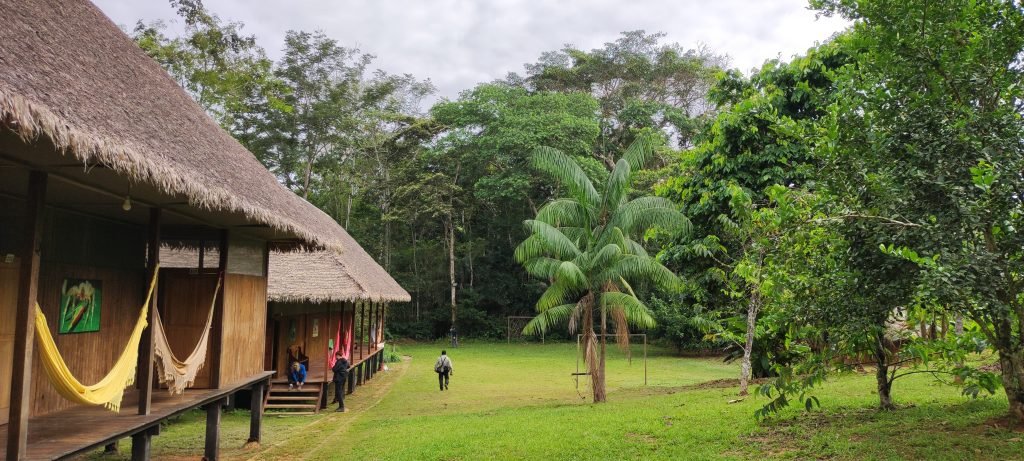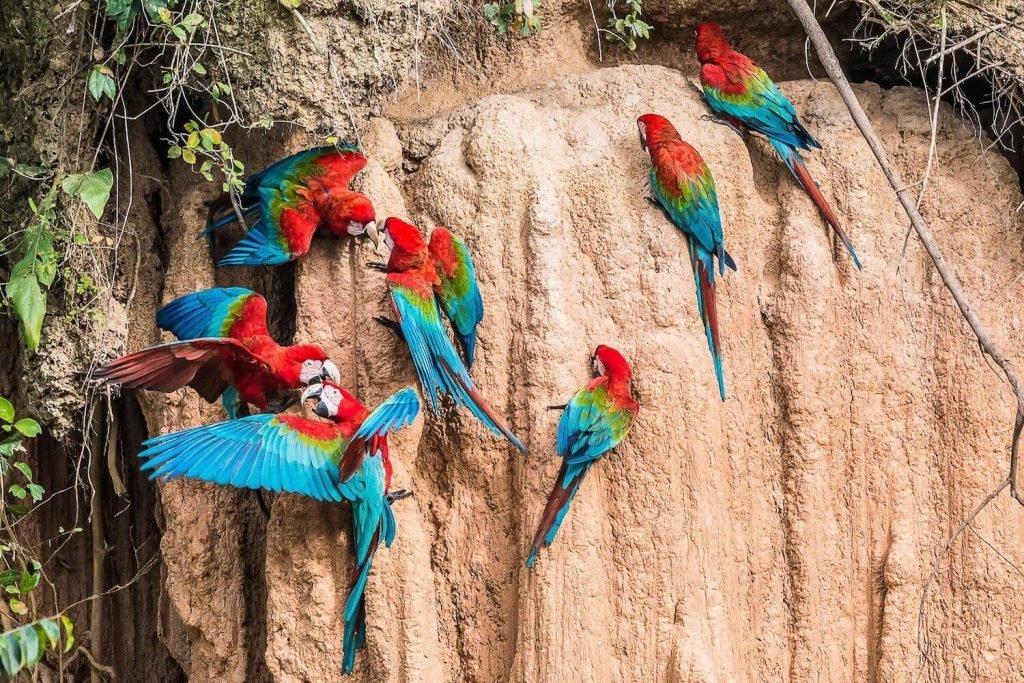Everything you need to know to travel to Tambopata
This Amazonian destination in Peru is home to some of the wildest and best preserved habitats in the world. It is on the list of “must-see” natural destinations in Peru and South America. However, planning a trip to Tambopata can be confusing. There is a lot of information on the Internet about the destination, lodges and tour operators. First of all you need to know what we mean by Tambopata, this can refer to the river that runs through the area, as well as the province and a national reserve that is home to a large number of endangered species. If you want to get to the reserve you have to pass through the city of Puerto Maldonado, which borders directly with another great natural destination: Bahuaja Sonene National Park, as you should also know that this destination shares visits with two other recommended spots in the Peruvian Amazon: Manu and Iquitos. Don’t worry, if you have any confusion we will try to solve it in this article.
What is Tambopata?
Most people know Tambopata because of the Tambopata River and the huge Tambopata National Reserve that protects it. Tambopata is also one of the provinces that make up the Amazonian state of Madre de Dios. However, in this article we will talk specifically about the Tambopata National Reserve.
Tambopata is a Quechua word, with Tambo meaning structure or building, and pata meaning “high place”. The name comes from the Tambopata River, which rises in the mountainous area of Puno, near Lake Titicaca, and descends towards this part of the country.
The largest town in Tambopata is Puerto Maldonado, and it is there that most travelers begin their journey through the jungle. Best of all, Tambopata is adjacent to other rainforest reserves, such as the Bahuaja Sonene National Park, so if you want to see the full extent of Peru’s Amazon area and the reserves that make it up you should consider taking a trip through these unique and unparalleled destinations, which will give you the experience of a lifetime.
What can be seen in Tambopata?
When travelers decide to visit Tambopata, they usually visit the Tambopata National Reserve and its surroundings. The reserve is huge and protects 274,690 hectares (1,061 square miles) of pristine wilderness, isolated from industrial and urban contact. To give you an idea, it is the size of the emblematic Yosemite National Park in the United States. It contains a great diversity of habitats, from Amazon rainforest to bamboo forests, from floodplains and wetlands to meander lakes and palm swamps, definitely a very complete destination for nature lovers.
Thanks to this variety of well-preserved habitats, Tambopata is one of the most biodiverse areas in the world. There are more than 1,000 species of butterflies, 100 species of mammals, 600 species of birds and hundreds of species of trees and plants which you can observe, visit and interact with during your visit. You are also likely to see monkeys, parrots and macaws, caimans, toucans and much more.
Who lives in Tambopata?
Tambopata is also home to the Ese Eja people, an indigenous nation that has lived in the rainforest region for many years. “Ese Eja” literally means people. There are three native Ese Eja communities around the Tambopata National Reserve: the community of Infierno (about 200 families), the community of Palma Real (about 50 families) and the community of Sonene (about 20 families). The tour operators that operate tours to the area collaborate with the surrounding communities, working together on nature and heritage conservation projects, and responsibly and fairly managing the income from ecotourism or responsible tourism.
Traditionally, the Ese Eja community are hunters, fishermen and farmers, although now many families also have commercial or tourism connections. Today, tourism and Brazil nut collection (a type of sustainable food production) are the two main economic activities within the Tambopata National Reserve. Around the reserve, tropical food crops such as papaya, pineapple and cacao are more common. Although tourism has grown in Tambopata in recent years, the region and the reserve are so vast that they are never crowded, offering an intimate and deeply wild experience of pure connection with nature.
Tambopata is now one of Peru’s top tourist destinations but, due to its enormous size, it is not overcrowded. If you like or love nature, Tambopata is your destination par excellence.
How to get to Tambopata?
To get to the Tambopata National Reserve the first step is to get to the city of Puerto Maldonado. This city is considered the entrance to the reserve and the capital of Madre de Dios. There are daily flights to Puerto Maldonado from several Peruvian destinations, mainly Cusco and Lima, which you can find at least three times a day.
Flights from Lima depart from the domestic terminal at Jorge Chavez airport. Direct flights take approximately 1 hour and 40 minutes. Flights from Cuzco depart from the domestic terminal at Velasco Astete airport. The trip can take between 3.5 and 4.5 hours, as they make a stopover in Lima beforehand.
You can also arrive by bus to the city of Puerto Maldonado, but this is not very advisable since the road can present inconveniences during the rainy season and can affect your trip and your travel time.
In Puerto Maldonado, most of the lodge companies and tour operators will be waiting for you at the airport arrivals terminal. From there, you will board a bus to the river ports. Once at the port, you will board boats to continue to the lodges located deep in the jungle. The lodges are 1 to 4 hours by boat from the port. Keep in mind that the longer you spend, the better and purer the wildlife will be.
Boat schedules are designed to fit in with arrival and departure flights, but you should not arrive after 15.00, because then you may have to travel by boat in the dark, before arriving at your lodge. The boat rides are great. You are likely to see capybaras and caimans on the Tambopata River and, with a lot of luck, a jaguar!
When to travel to Tambopata?
Tambopata is slightly seasonal, although the temperate zone does not perceive these changes. It is important to know that it can rain at any time of the year, Tambopata is slightly drier from April to November, when the rains stop and start, respectively. The rainiest months are between January and February, but even then it rarely rains in torrents.
The advantage of visiting Tambopata in the dry season is that there is very little chance of activities being affected by rain, and roads will be less muddy and easier to navigate.
The advantages of visiting the country in the rainy season are that the macaws are more active in the Collpas and are in the nesting season. If you like macaws, the perfect time to visit Tambopata is between December and February, when the nesting season is in full swing, you will be able to observe huge numbers of macaws bathing the Amazonian sky with their squawks.
What to do in Tambopata?
This is a key question: no one goes to the Amazon to stay in a lodge and spend their days cooped up. The vast majority of tour operators include outdoor activities in the price of your stay. In Tambopata, you don’t just get up and choose which trail to follow (that’s for Paris!). Nor do you sit down and do nothing (that’s for Cancun!). Nor do you have a single choice of trail to follow to reach a destination (that’s for the Inca Trail!). Each day, in Tambopata, your operator offers you a variety of different activities to choose from, and most of them should be included in your rate, try to organize your time well and have all the necessary information about the activities you want to do, don’t miss the most important and unique spots in Tambopata.
There are many activities. But you should stay at least three nights to be able to do all of them calmly, some examples are:
- Boat or canoe ride through the oxbow lakes.
- Observation tower or canopied walkway.
- Clay ponds.
Biodiversity of Tambopata
The lowland forests and tropical savannas of Tambopata are some of the most biodiverse areas on the planet, if you are a fan of bird watching, monkeys or any species that intrigues you this place will offer you the best strategic observation points with unique experiences.
Birds: 670 bird species have been identified, including the harpy eagle, a large and rare raptor that preys on monkeys and sloths, the rare hoatzin and eight species of macaws (six of which can be seen at the Tambopata Research Center lick).
Mammals: 200 species, including healthy populations of jaguar, giant anteater, Amazonian tapir and, in the savannah habitats of the Heath River, the maned wolf.
Reptiles and amphibians: 210 species, including several species of tree frogs, the colorful Tambopata poison frog and the beautiful rainbow boa.
Insects and other arthropods: The number of insect and spider species living in Tambopata’s rainforests is in the thousands. Many are expected to be species unknown to science.
Trees and plants: More than 10,000 plant species have been identified in Tambopata (Peru), making it one of the most plant-diverse areas on the planet. Some of the most notable plants are the Brazil nut tree, the enormous Ceiba and the fast-growing balsa trees.
There are more than 1000 possible species of mammals, birds, reptiles and amphibians in Tambopata, although you will not be able to observe all of them at any time of the year.
Tambopata Lodges and Tours

In Tambopata, all lodges have a tour operator with whom they work in partnership. That means that the lodges will have boats to take you back and forth on your tours, will have guides to accompany you on your activities and are responsible for your entire trip, from picking you up at the airport to taking you back. However, there are some tour operators that do not work in conjunction with lodges. We will not focus on tour operators here. We will only focus on the lodges.
How do you know if the accommodation is good? Is it clean? Is the food good? Do the trucks and boats arrive on time? Is the staff friendly? Let visitors who have been there before help you with their comments. For any questions focused on the actual service, Trip Advisor is your best option, here you can find reviews of all the Lodges operating in Tambopata as well as the various Tours you can find.
You probably already know this, but TripAdvisor is the world’s largest travel review website. Search for the destination you want to go to and check out the top rated hotels. Before you start, you should know a few things about TripAdvisor’s destinations and hotel ratings.
What to bring on a trip to Tambopata
Here are some suggestions:
- Binoculars
- Photographic equipment, don’t forget your long-range lens!
- Tightly woven, light-colored, long-sleeved cotton pants.
- Long sleeved, tightly woven, light colored cotton shirts
- Ankle-high hiking boots and sneakers
- Flashlight (headlamp) with batteries
- Sunscreen
- Sunglasses
- Wide-brimmed hat
- Rain suit or poncho
- Insect repellent
- Small bills
- Small backpack
- Sneakers or sandals for walking around the lodges.
- Most lodges lend rubber boots so you don’t have to bring them.
We hope that in this article you have been able to unravel the doubts you had about this magnificent Amazon destination, if so do not hesitate to book your trip to Tambopata, this iconic place and all the species it houses are waiting for your visit.





